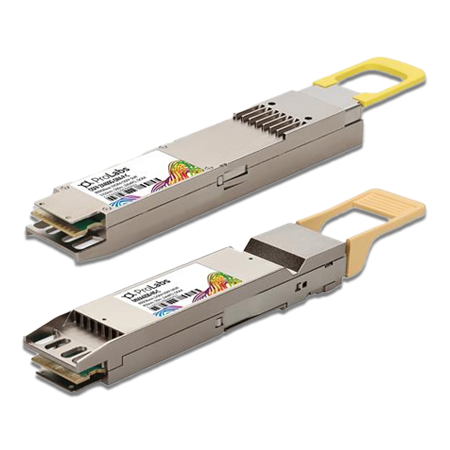Visit ProLabs at Booth #2924 to explore how our next-generation optical innovations are shaping the future of data center performance, scalability, and sustainability.
Join us for live Byte-Sized sessions throughout the week featuring ProLabs experts sharing insights on key trends and technologies driving high-speed networking.
Featured Topics:
- Preparing for the migration toward 1.6T and beyond
- Strategies to reduce power and latency
- Best practices for cable management and more
Featured Technologies:
- 1.6T Transceivers & DACs
- Multi-Coded Optics
- LPO Solutions
- Exclusive at SC25: Get an inside look at ProLabs’ next-generation Advanced Monitoring Transceivers — revealed first at the show.
1.6T Transceivers & DACs

1.6T technology is emerging as the answer to rising bandwidth demands in data centers, prompting planners, operators, and network architects to prepare for the next phase of network evolution. By introducing 224G signaling per lane, 1.6T delivers a significant performance upgrade for high-capacity data center applications.
Features & Benefits:
- Supports up to 1.6T transmission, enabling high-speed data transfer for next-gen networking applications.
- Low insertion loss and built-in EEPROM functions, optimizing signal integrity and system performance.
- Compliant with OSFP MSA and IEEE 802.3dj standards, ensuring seamless interoperability across multi-vendor environments.
Multi-Coded Optics

ProLabs’ Multi-Coded OSFP 800G transceivers (2×DR4 & 2×SR4) are engineered for seamless compatibility across Arista, Cisco, Juniper, and Mellanox environments—helping reduce inventory complexity while accelerating AI and high-performance computing (HPC) deployments.
Features & Benefits:
- 2×DR4 & 2×SR4 — optimized for mid-reach and short-reach applications
- True multi-vendor interoperability across Arista, Cisco, Juniper, and Mellanox
- 100% tested reliability, and backed by a lifetime warranty
LPO Solutions

LPO transceivers provide a low-power solution optimized for short-reach applications ranging from 500m to 2km. Without an onboard DSP, they are more sensitive to fiber conditions such as bends, splices, and connector losses. For longer-reach deployments exceeding 10km, DSP-based designs remain the preferred option for maintaining signal quality and performance.
Features & Benefits:
- Ideal where reducing power and cooling requirements is a top priority
- Designed for applications requiring increased port density is critical
- Optimized for low-latency connections in AI/ML workloads
Advanced Monitoring Transceivers

Powered by advanced DSP technology and integrated analytics, ProLabs’ Advanced Monitoring Transceivers detect performance trends before alarms are triggered, enabling operators to act proactively, minimize downtime, and maintain optimal network performance.
Features & Benefits:
- CMIS support enables tuning and management of coherent features within the switch CLI
- Supports 100G DWDM wavelengths over distances up to 80km
- Functions as a 100G tunable coherent optic
Byte Size Theater Schedule
| Monday | |||
|---|---|---|---|
| 8:00 PM | Not All Transceivers Are Equal: Make the Choice That Pays Off | Tom Hurley | Not all transceivers are created equal—and where you buy them could be the smartest or costliest decision you make. This session highlights how these choices impact network performance, warranty compliance, and total cost of ownership. |
| 8:30 PM | Flat Top vs. Finned: How to Find Your Way in the Transceiver Jungle | Ray Hagen | From flat tops to fins and everything in between—if transceiver form factors feel like a jungle, this session hands you the map. This session demystifies the evolving world of transceiver form factors, helping you navigate the shift toward next-generation optics. We’ll break down what terms like “flat top” vs. “finned” really mean, and how these physical designs impact thermal performance and deployment decisions. You’ll also learn how parallel series optics are reshaping network architecture and what that means for your future planning. |
| Tuesday | |||
| 11:00 AM | Decision Points: AOC or Transceiver | Ray Hagen | When every port counts and every meter matters, the choice between AOCs and transceivers isn’t just technical—it’s strategic. This session will compare performance, cost, flexibility, and operational tradeoffs to help guide optimal infrastructure decisions. Attendees will leave with a clear framework for selecting the right solution based on application needs, scalability, and total cost of ownership. |
| 12:00 PM | Not All Transceivers Are Equal: Make the Choice That Pays Off | Tom Hurley | Not all transceivers are created equal—and where you buy them could be the smartest or costliest decision you make. This session highlights how these choices impact network performance, warranty compliance, and total cost of ownership. |
| 1:00 PM | Strategies to Reduce Power Consumption | Ray Hagen | In AI networks, power isn’t just a cost—it’s a constraint on scale. This session explores how emerging optical transceiver technologies like LPO (linear pluggable optics) and TRO/LRO (transmit/linear receive optics) help reduce power consumption in high-performance environments. Attendees will learn about the tradeoffs between LPO, LRO/TRO, and traditional re-timed (DSP-based) transceivers to make informed decisions for energy-efficient infrastructure. |
| 3:00 PM | Optical Strategies for Ultra-Low Latency Networks | Rick Mitchell | This session dives into the specialized world of ultra-low latency optical networks, where every nanosecond counts—especially for high-frequency trading and other time-sensitive applications. We’ll explore how to minimize latency through smart optical design choices while also reducing power consumption. Attendees will gain insights into the tradeoffs and technologies that enable lightning-fast, energy-efficient connectivity. |
| 5:00 PM | Simplifying Multi-Vendor Networks | Ray Hagen | When your network speaks multiple vendor languages, multi-coded cables and optics are the universal translator you didn’t know you needed. This session explores how multi-coded cables and optics can streamline operations in multi-vendor environments by ensuring seamless interoperability. Attendees will learn how these solutions reduce complexity, minimize inventory requirements, and improve network agility. The session offers practical strategies for simplifying procurement and deployment without sacrificing performance or vendor flexibility. |
| Wednesday | |||
| 11:00 AM | Lessons Learned from Large AI Clusters | Ray Hagen | Building AI clusters at scale isn’t just about GPUs—it’s about getting everything else right, fast. This session shares real-world lessons from deploying large-scale AI infrastructure, focusing on the hidden challenges that can derail timelines and budgets. Key topics include pre-sale validation, strategies to reduce “standing army” costs, and optimizing the burn-in phase to accelerate time-to-revenue. |
| 12:00 PM | Not All Transceivers Are Equal: Make the Choice That Pays Off | Tom Hurley | Not all transceivers are created equal—and where you buy them could be the smartest or costliest decision you make. This session highlights how these choices impact network performance, warranty compliance, and total cost of ownership. |
| 1:00 PM | Crossing the Terabit Threshold: What 224G Lanes Mean for Your Network | Ray Hagen | As network speeds surge toward 1.6T and beyond, the rules of interoperability are being rewritten. This session explores the impact of rising per-lane data rates—like 224G—on system design, signal integrity, and cross-platform compatibility. Attendees will gain a clearer understanding of the challenges and innovations shaping the next generation of high-speed optical networks. |
| 3:00 PM | Harnessing Order: Why Cable Design Matters in High-Density AI Environments | Andrew Milburn | In AI racks, messy cables aren’t just an eyesore—they’re a deployment delay waiting to happen. This session highlights how purpose-built cable harness assemblies are ideal for AI rack elevations, streamlining in-cabinet organization. Attendees will learn how these assemblies reduce deployment time, lower costs, and improve airflow and serviceability in high-density environments. |
| 5:00 PM | Stop Monitoring and Start Observing your Cluster | Ray Hagen | In AI-driven networks, surface-level monitoring won’t cut it—observation is the new superpower. This session explores how the intense demands of AI workloads expose hidden stress points in hardware, especially optical transceivers. Attendees will learn how deep observability enables faster root cause analysis, better performance tuning, and more resilient infrastructure at scale. |
| Thursday | |||
| 11:00 AM | Flat Top vs. Finned: How to Find Your Way in the Transceiver Jungle | Ray Hagen | From flat tops to fins and everything in between—if transceiver form factors feel like a jungle, this session hands you the map. This session demystifies the evolving world of transceiver form factors, helping you navigate the shift toward next-generation optics. We’ll break down what terms like “flat top” vs. “finned” really mean, and how these physical designs impact thermal performance and deployment decisions. You’ll also learn how parallel series optics are reshaping network architecture and what that means for your future planning. |
| 12:00 PM | Harnessing Order: Why Cable Design Matters in High-Density AI Environments | Andrew Milburn | In AI racks, messy cables aren’t just an eyesore—they’re a deployment delay waiting to happen. This session highlights how purpose-built cable harness assemblies are ideal for AI rack elevations, streamlining in-cabinet organization. Attendees will learn how these assemblies reduce deployment time, lower costs, and improve airflow and serviceability in high-density environments. |
See It All at SC25
Discover how ProLabs is advancing the next wave of optical innovation for AI-driven, high-performance networks.
Contact a ProLabs expert today to learn more.


